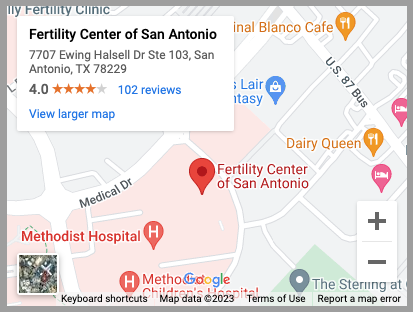Discover Your Path to Parenthood Today.
Laparoscopy: An Advanced Way to Diagnose and Treat Infertility
Laparoscopy is a minimally-invasive surgical procedure that allows our doctors to view images of your reproductive tract. Our doctors at the Fertility Center of San Antonio utilize laparoscopy as an advanced way to gather information about your fertility and perform procedures. In this way, our patients in the greater San Antonio, TX, area can have a more comfortable experience with less downtime following their treatment. Our team has spent over 30 years helping patients overcome fertility issues. We strive to find the most minimally invasive treatment options while providing effective care.

What Is It Used For?
Laparoscopy is often used to determine the cause of pelvic pain, or to diagnose and treat health conditions or infertility. Laparoscopy is usually performed when noninvasive diagnostic tools, like an MRI or ultrasound, do not provide sufficient information for a diagnosis. Additionally, this procedure combined with in vitro fertilization (IVF) or other assisted reproductive technologies can greatly increase your chances of becoming pregnant.
You may need to undergo a laparoscopy for:
- The removal of fibroids, ovarian cysts, or ectopic pregnancy
- Diagnosis or treatment of infertility, pelvic pain, endometriosis, or pelvic inflammatory disease (PID)
The Advantages of Laparoscopy
Laparoscopy has become the preferred method to performing surgery due to some key advantages over traditional open procedures, including:
- Smaller incision sites
- Less pain and swelling
- Reduced down time
- Quicker healing times
What to Expect during the Procedure
Laparoscopy is usually performed under general anesthesia. Once you are asleep, a thin device with a light and camera at the end (laparoscope) is threaded via a small incision along the navel. The abdomen is then filled with carbon dioxide, expanding the area and optimizing visualization of the organs. Depending on the purpose of the laparoscopy, additional surgical instruments may be inserted through the same incision, or another one at the midsection.
Laparoscopy allows for quicker recovery times and less pain and swelling than traditional open surgeries.
Your surgeon will then perform the techniques and maneuvers specific to your procedure, which may include other diagnostic or treatment modalities, such as a hysteroscopy. When the procedure is complete, your surgeon will remove the carbon dioxide, laparoscope, and other surgical instruments, and suture the incision sites.
Recovery and Results
A laparoscopic surgery is typically an outpatient procedure, allowing you to be discharged the same day to recover at home. Patients often feel tired following surgery and may experience nausea from the anesthesia, which should dissipate the same day. In some cases, patients may have the following minor side effects for a few days, such as:
- Abdominal bloating
- Sore throat
- Discomfort at the incision sites
- Shoulder or back pain
If a biopsy, or tissue sample, was taken during your procedure, a pathologist will examine this and report on it to your doctor. Together, you and your doctor will review the report or other findings when they are available. They can also discuss potential treatment options with you.
If you had another treatment performed during your laparoscopy, your results will be different. Our team can walk you through what to expect after your laparoscopic treatment.
Learn More about Laparoscopy
At Fertility Center of San Antonio, we are dedicated to providing supportive, cost-effective care for our patients. Call our office today at (210) 692-0577, or contact our office online. We are happy to speak with you and answer your questions.











